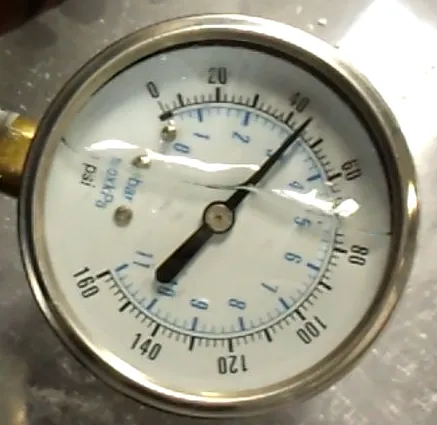
What's wrong with my air tool?
My air tool doesn't perform well, what's wrong?
Complaints about poorly performing compressed air tools are quite common at industrial sites. The tools may lack torque, and stall if any significant load is put on them. This lack of output could be reducing your production output and therefore be costing you money.
Many times the source of the problem is poorly designed supply components, the filters, regulators, lubricators, connectors, hoses and fittings used in transporting the compressed air to your tool are not the correct size. If these are not properly selected then the tool may receive air pressure that is much lower than its rating, and the result is lower tool performance.
A very easy way to check to see if you have a problem is to rig up a little test jig using an accurate pressure gauge, a T connection, and some quick connect couplers. Place the test gauge in series with the tool and check the pressure. Perhaps your typical system pressure is 100 psi, that is what you would see on the gauge with the tool at rest. Should the feed to the tool be regulated, then you would see the regulator is set pressure. If no air is flowing to the tool there should be no pressure drop in any of the supply components that exclusively feed the tool.
Next, operate the tool, once there is a flow of air any pipeline restrictions will develop a pressure differential. This will reduce the pressure at the test jig. Observe the pressure and compare it with the initial pressure. If the pressure drops excessively, to levels below the rating of the tool, then you have a problem.
Are you wondering what specific component is causing the problem, them move the gauge upstream and test again. By carefully recording the pressure drop caused by the tool operation you can usually isolate the problem to one or more components.
But what is causing the pressure restriction? Often industrial plants choose to install just one common size of components for every tool and piece of equipment in the plant. But the compressed air flow of different machines and tools can vary widely. A ¼ inch hose may be a good size for a small pneumatic screwdriver, but if applied to a large impact wrench, then poor tool performance results. Carefully investigating each air tool flow demand requirement will allow you to properly size supply components for the low pressure drop required to keep the tool at or above its rated pressure during operation.
Photo: The tool measured by this gauge was rated at 90 psi and did not perform adequately at 44 psi.
Learn more about pressure drop at our training: www.compressedairchallenge.org/calendar
